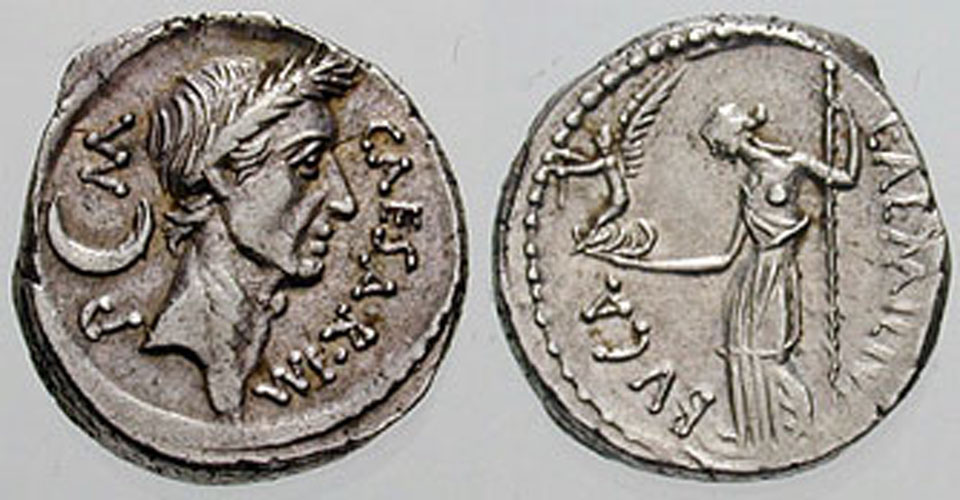29. February 2024
凱撒大帝 kah 閏年

探索宇宙1!逐工會揀一幅無仝款 ê 影像抑是相片,𤆬你熟似咱這个迷人 ê 宇宙,閣有專業天文學者2為你3解說4。
- 原始文章:Julius Caesar and Leap Days
- 影像來源 kah 許可:Classical Numismatic Group, Inc., Wikimedia
- 台文翻譯:An-Li Tsai (NSYSU)
[漢羅] 凱撒大帝 kah 閏年
凱撒大帝 tī 西元前 46 年 ê 時陣重新修定曆法。 根據 Alexandria 城 ê 天文學家 Sosigenes ê 建議,新 ê 曆法包括 4 年出現一改 ê 潤日,因為地球一冬是比 365 工閣較長淡薄仔。 用現代 ê 術語來講,地球踅太陽一輾需要 ê 時間是 365.24219 个平均太陽日。 所以,曆日 一冬若是干焦 365 工,按呢 4 冬落來就會差一工。 時到北半球就會發生 7 月出現 tī 寒天 ê 代誌。 是講這个 7 月就是用 凱撒大帝 號名 ê 月份。 若是每四冬加一个潤年,這款影響就會較少。 1582 年 ê 時陣,天主教教宗 Pope Gregory 十三世 kā 改做尾數 00 年 ê 時陣莫潤,等到 尾數 400 ê 時陣才閣潤。 這款 Gregorian 曆法 就是這馬咱咧用 ê 新曆。 是講,地球月球系統 ê 潮汐摩擦力 會 kā 地球 ê 自轉速度變較慢,按呢就會予地球一工變較長,逐世紀會增加 1.4 毫秒。 抑就是講,閣過 400 萬年以後,像今年這款潤年就變做無必要矣。 這个羅馬龍銀 denarius ê 倒爿是 凱撒大帝 ê 頭像,正爿是 羅馬愛神 維娜斯。
[POJ] Khái-sat Tāi-tè kah Jūn-nî
Khái-sat Tāi-tè tī se-goân chêng 46 nî ê sî-chūn tiông-sin siu-tēng le̍k-hoat. Kin-kì Alexandria siâⁿ ê thian-bûn ha̍k-ka Sosigenes ê kiàn-gī, sin ê le̍k-hoat pau-koat 4 nî chhut-hiān chi̍t kái ê jūn-ji̍t, in-ūi Tē-kiû chi̍t tang sī pí 365 kang koh-khah tn̂g tām-po̍h-á. Iōng hiān-tāi ê su̍t-gí lâi-kóng, Tē-kiû se̍h Thài-iông chi̍t liàn su-iàu ê sî-kan sī 365.24219 ê pêng-kin thài-iông-ji̍t. Só͘-í, la̍h-ji̍t chi̍t tang nā-sī kan-na 365 kang, án-ne 4 tang lo̍h-lâi to̍h ē chha chi̍t-kang. Sî-kàu pak-pòaⁿ-kiû tō ē hoat-seng 7 goe̍h chhut-hiān tī kôaⁿ-thiⁿ ê tāi-chì. Sī-kóng chit-ê 7 goe̍h to̍h sī iōng Khái-sat Tāi-tè hō-miâ ê goe̍h-hūn. Nā-sī múi sì tang ke chi̍t-ê jūn-nî, chit-khoán éng-hióng to̍h ē khah chió. 1582 nî ê sî-chūn, Thian-chú-kàu Kàu-chong Pope Gregory cha̍p-saⁿ sè kā kái-chò bóe-sò͘ 00 nî ê sî-chūn mài jūn, tán kàu-bóe-sò͘ 400 ê sî-chūn chiah-koh jūn. Chit-khoán Gregorian le̍k-hoat tio̍h-sī chit-má lán leh iōng ê sin-le̍k. Sī-kóng, Tē-kiû Goe̍h-kiû hē-thóng ê tiau-se̍k mô͘-chhat-le̍k ē kā Tē-kiû ê chū-choán sok-tō͘ piàn khah bān, án-ne to̍h ē hō͘ Tē-kiû chi̍t-kang piàn khah tn̂g, ta̍k sè-kí ē cheng-ka 1.4 hô-bió. Ia̍h to̍h sī kóng, koh kòe 400 bān-nî í-āu, chhiūⁿ kin-nî chit-khoán jūn-nî to̍h piàn-chò bô pit-iàu--ah. Chit-ê Lô-má lêng-gîn denarius ê tò-pêng sī Khái-sat Tāi-tè ê thâu-siōng, chiàⁿ-pêng sī Lô-má Ài-sîn Ûi-ná-su.
[KIP] Khái-sat Tāi-tè kah Jūn-nî
Khái-sat Tāi-tè tī se-guân tsîng 46 nî ê sî-tsūn tiông-sin siu-tīng li̍k-huat. Kin-kì Alexandria siânn ê thian-bûn ha̍k-ka Sosigenes ê kiàn-gī, sin ê li̍k-huat pau-kuat 4 nî tshut-hiān tsi̍t kái ê jūn-ji̍t, in-uī Tē-kiû tsi̍t tang sī pí 365 kang koh-khah tn̂g tām-po̍h-á. Iōng hiān-tāi ê su̍t-gí lâi-kóng, Tē-kiû se̍h Thài-iông tsi̍t liàn su-iàu ê sî-kan sī 365.24219 ê pîng-kin thài-iông-ji̍t. Sóo-í, la̍h-ji̍t tsi̍t tang nā-sī kan-na 365 kang, án-ne 4 tang lo̍h-lâi to̍h ē tsha tsi̍t-kang. Sî-kàu pak-puànn-kiû tō ē huat-sing 7 gue̍h tshut-hiān tī kuânn-thinn ê tāi-tsì. Sī-kóng tsit-ê 7 gue̍h to̍h sī iōng Khái-sat Tāi-tè hō-miâ ê gue̍h-hūn. Nā-sī muí sì tang ke tsi̍t-ê jūn-nî, tsit-khuán íng-hióng to̍h ē khah tsió. 1582 nî ê sî-tsūn, Thian-tsú-kàu Kàu-tsong Pope Gregory tsa̍p-sann sè kā kái-tsò bué-sòo 00 nî ê sî-tsūn mài jūn, tán kàu-bué-sòo 400 ê sî-tsūn tsiah-koh jūn. Tsit-khuán Gregorian li̍k-huat tio̍h-sī tsit-má lán leh iōng ê sin-li̍k. Sī-kóng, Tē-kiû Gue̍h-kiû hē-thóng ê tiau-si̍k môo-tshat-li̍k ē kā Tē-kiû ê tsū-tsuán sok-tōo piàn khah bān, án-ne to̍h ē hōo Tē-kiû tsi̍t-kang piàn khah tn̂g, ta̍k sè-kí ē tsing-ka 1.4 hô-bió. Ia̍h to̍h sī kóng, koh kuè 400 bān-nî í-āu, tshiūnn kin-nî tsit-khuán jūn-nî to̍h piàn-tsò bô pit-iàu--ah. Tsit-ê Lô-má lîng-gîn denarius ê tò-pîng sī Khái-sat Tāi-tè ê thâu-siōng, tsiànn-pîng sī Lô-má Ài-sîn Uî-ná-su.
[English] Julius Caesar and Leap Days
In 46 BC Julius Caesar reformed the calendar system. Based on advice by astronomer Sosigenes of Alexandria, the Julian calendar included one leap day every four years to account for the fact that an Earth year is slightly more than 365 days long. In modern terms, the time it takes for the planet to orbit the Sun once is 365.24219 mean solar days. So if calendar years contained exactly 365 days they would drift from the Earth's year by about 1 day every 4 years and eventually July (named for Julius Caesar himself) would occur during the northern hemisphere winter. By adopting a leap year with an extra day every four years, the Julian calendar year would drift much less. In 1582 Pope Gregory XIII provided the further fine-tuning that leap days should not occur in years ending in 00, unless divisible by 400. This Gregorian Calendar system is the one in wide use today. Of course, tidal friction in the Earth-Moon system slows Earth's rotation and gradually lengthens the day by about 1.4 milliseconds per century. That means that leap days like today will not be necessary, about 4 million years from now. This Roman silver coin, a denarius, depicts Julius Caesar (left) and Venus, Roman goddess of love.
詞彙學習
| 漢羅 | POJ | KIP | 華語 | English |
|---|---|---|---|---|
| 凱撒大帝 | Khái-sat tāi-tè | Khái-sat tāi-tè | 凱撒大帝 | Julius Caesar |
| 曆法 | le̍k-hoat | li̍k-huat | 曆法 | calendar system |
| 潤日 | jūn-ji̍t | jūn-ji̍t | 潤日 | leap day |
| 潤年 | jūn-nî | jūn-nî | 潤年 | leap year |
| 平均太陽日 | pêng-kun thài-iông-ji̍t | pîng-kun thài-iông-ji̍t | 平均太陽日 | mean solar day |
| 龍銀 | lêng-gîn | lîng-gîn | 銀幣 | silver coin |
| 潮汐摩擦力 | tiâu-se̍k mô͘-chhat-le̍k | tiâu-si̍k môo-tshat-li̍k | 潮汐摩擦力 | tidal friction |
| 自轉 | chū-choán | tsū-tsuán | 自轉 | rotation |
| 維娜斯 | Ûi-ná-su | Uî-ná-su | 維納斯 | Venus |